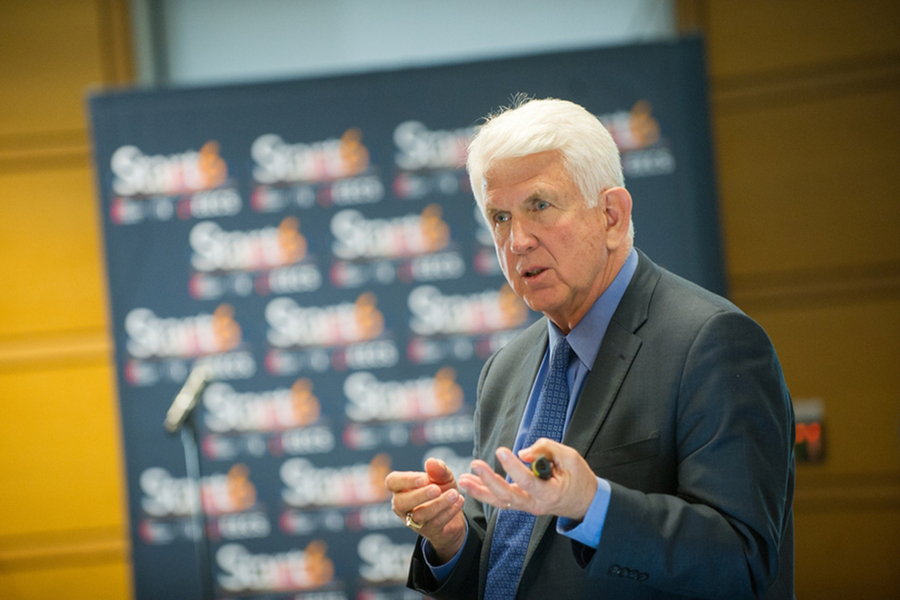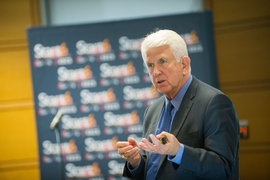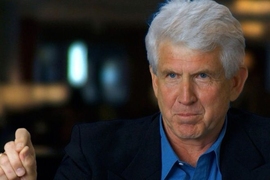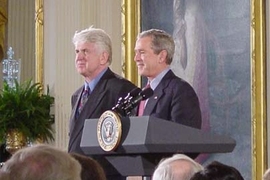Robert “Bob” Metcalfe ’69, an MIT Computer Science and Artificial Intelligence Laboratory (CSAIL) research affiliate and MIT Corporation life member emeritus, has been awarded the 2022 Association for Computing Machinery (ACM) A.M. Turing Award for his invention of Ethernet. Often referred to as the “Nobel Prize of computing,” the award comes with a $1 million prize provided by Google.
Metcalfe, the founder of 3Com Corp., the company that designed, developed, and manufactured computer networking equipment and software, was cited by the ACM for the “invention, standardization, and commercialization of Ethernet,” one of the earliest and most extensively utilized networking technologies. 3Com, Metcalfe's Silicon Valley startup founded in 1979, helped to increase the commercial viability of Ethernet by selling network software, Ethernet transceivers, and Ethernet cards for minicomputers and workstations. 3Com introduced one of the first Ethernet interfaces for IBM PCs and their clones when IBM launched its personal computer.
A current research affiliate in computational engineering at MIT, Metcalfe is also an emeritus professor of electrical and computer engineering after 11 years at The University of Texas at Austin. Metcalfe graduated from MIT in 1969 with bachelor's degrees in electrical engineering and industrial management.
“Bob’s work has profoundly impacted computer science and the world, which cannot be overstated,” says Daniela Rus, director of CSAIL and the Andrew and Erna Viterbi Professor in the MIT Department of Electrical Engineering and Computer Science (EECS). “With the invention of Ethernet, he enabled seamless communication and information sharing, paving the way for countless applications that have become integral to our daily lives. From the internet to online video streaming and beyond, Ethernet has formed the foundation of modern technology and transformed how we connect. It's hard to fathom life without the connectivity that Ethernet has made possible.”
Ethernet, commence
Metcalfe’s renowned 1973 memo on a “broadcast communication network” proposed linking the first personal computers, PARC's Altos, in a single building, which paved a way for the devices to talk to each other and share information in a local area network. The first Ethernet clocked in at 2.94 megabits per second, approximately 10,000 times faster than the terminal networks it replaced. The memo suggested that the network should be adaptable to new technologies such as optical fiber, twisted pair, Wi-Fi, and power networks and to swap out the original coaxial cable as the primary means of communication to “over an ether.” The contribution was later immortalized in their 1976 Communications of the ACM article, “Ethernet: Distributed Packet Switching for Local Computer Networks.”
But what came before Ethernet? Metcalfe likes to call it some version of luck. “My first task at Xerox was to put it on the ARPANET, which I had already done for Project MAC. I built the necessary hardware and software and Xerox got it connected. Later, the Computer Science Lab at Xerox PARC aimed to create the first modern personal computer and have one on every desk — imagine that,” he says. “So they asked me to design a network for this purpose. I was given a card with 60 chips for the network. That was the second-biggest stroke of luck in my life. The first one was being born to my parents.”
Metcalfe was not alone in pursuing efficient network communication; he connected as well with David Boggs, the co-inventor of Ethernet, who passed away last year. Metcalfe and Boggs set out to avoid using wires, an idea that was short-lived. “We went to a place that had packet radio network at the University of Hawaii and saw immediately that we couldn't have zero wires. The radios were just too big and expensive and slow. We'd have to have more than zero wires, so we decided to have one. And this one wire would be shared among the attached PCs.”
Making things standard
Metcalfe and Boggs cooked up a recipe of Jerrold taps, Manchester encoding, and ALOHA randomized retransmissions to bring Ethernet to life. The first would puncture the coaxial cable and attach to the central conductor without cutting the cable. Manchester encoding allowed the clock to be in the packet. Finally, ALOHA randomized retransmissions allowed for turn-taking. The two then built and attached many stations to the Ethernet and wrote network protocols to use it.
“We had to make Ethernet standard. I served as the so-called 'marriage broker' connecting Digital Equipment Corporation, then the second-largest computer company in the world, and Intel Corporation, a brand new semiconductor company, and Xerox Corporation, a large systems vendor,” says Metcalfe. “We created the DIX Ethernet standard and submitted it to the IEEE. A couple of painful years later, it got standardized. Then a big fight ensued between the Ethernet companies and IBM and General Motors, a three-way battle. General Motors lost quickly, and IBM hung on for 20 years. All of them wanted their technology to be the standard everybody used to connect computers. Ethernet won.”
Today, Ethernet is the main conduit of wired network communications worldwide, handling data rates from 10 megabits per second to 400 gigabits per second (Gbps), with 800 Gbps and 1.6 terabits per second technologies emerging. As a result, Ethernet has also become an enormous market, with revenue from Ethernet switches alone exceeding $30 billion in 2021, according to the International Data Corp.
Life at MIT
MIT has long been a second home to Metcalfe, where he could not stay away for long.
From 1970 to 1972, he worked on putting MIT on the ARPANET in J.C.R. Licklider's dynamic modeling systems group. “This was all on the ninth floor of Tech Square — where everything interesting in the world was happening” says Metcalfe. “I returned to MIT in 1979, after I left Xerox, and became a consultant to Michael Dertouzos. I was peddling Ethernet, and Mike's people were peddling something called a 'token ring.' He and I were on opposite sides of a big argument. He was pro-token ring, and I was pro-Ethernet. Dertouzos wanted me to join that fight, which I did through most of 1979, during which I founded the 3Com Corporation while at LCS.”
Metcalfe has been a member of the MIT Corporation since 1992. In 1997-98 he served as president of the MIT Alumni Association. He served as MIT Visiting Innovation Fellow with the Innovation Initiative and Department of Electrical Engineering and Computer Science during the 2015-16 academic year, during which he mentored students on all things entrepreneurship. In 2022, Metcalfe joined CSAIL as a research affiliate to pursue research in computational engineering.
“Ethernet is the foundational technology of the internet, which supports more than 5 billion users and enables much of modern life,” says Jeff Dean, Google Senior Fellow and senior vice president of Google Research and AI, in the official ACM announcement. “Today, with an estimated 7 billion ports around the globe, Ethernet is so ubiquitous that we take it for granted. However, it's easy to forget that our interconnected world would not be the same without Bob Metcalfe's invention and his enduring vision that every computer must be networked.”
Past Turing Award recipients who have taught at MIT include Sir Tim Berners-Lee (2017), Michael Stonebraker (2014), Shafi Goldwasser and Silvio Micali (2013), Barbara Liskov (2008), Ronald Rivest (2002), Butler Lampson (1992), Fernando Corbato (1990), John McCarthy (1971) and Marvin Minsky (1969).
Metcalfe will be formally presented with the A.M. Turing Award at the annual ACM Awards Banquet, held this year on June 10 at the Palace Hotel in San Francisco.









